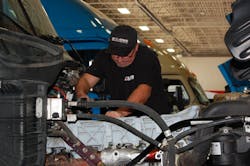NACFE: Fleets should switch to low-viscosity engine oils
The latest Confidence Report issued by the North American Council for Freight Efficiency (NACFE) indicates that Class 8 tractors can gain anywhere from 0.5% to 1.5% in fuel economy when switching from 15W-40 oils to current CJ-4 5W-30 or 10W-30 blends or to CK-4 5W-30 and 10W-30 blends derived from the new PC-11 classification, which will be available in December this year.
NACFE’s researchers also found a further 0.4% to 0.7% gain in fuel economy on top of that 0.5% to 1.5% improvement can be obtained by switching to the new FA-4 low viscosity PC-11 variant, though the backward compatibility of that oil remains a major unknown, according to Mike Roeth, the group’s executive director.
“Fleets don’t want two oils in their systems: we heard that loud and clear in our interviews,” he explained in a conference call with reporters. “So we hope to see work go on to approve these oils as far backward as possible.”
He added that it “feels like we’ve got a tipping point here” in terms of getting the trucking industry to switch to lower viscosity oils, even the new FA-4 grade despite that backward compatibility issue.
“The old axiom that heavier oils will protect my engine better is falling apart now,” Roeth said. “I went in with assumption that FA-4 would not backward compatible. But as we start testing older engines with the newer [FA-4] oils, it may be. I expect there to be a growing amount of test data on this.”
In engineering terms, the reports primary author Yunsu Park noted that “viscosity” is defined as a measure of a fluid’s internal resistance to flow. Thus within a truck’s engine, mechanical losses from pumping and friction consume approximately 16% of the total energy input to the vehicle. Using lower-viscosity oil, then, will reduce such engine mechanical losses – thereby reducing fuel use.
Though NACFE is recommending that fleets use the low-end of the fuel economy scale in its report – 0.5% – to conduct payback analysis regarding a switch to low-viscosity blends, Roeth noted that “a half percent fuel economy at $2 or $3 per gallon [diesel] fuel is still hundreds of dollars in savings per truck per year.”
NACFE noted several other factors that need to be weighed if fleets contemplate switching to low-viscosity engine oils:
- For fleets using non-synthetic 15W-40 oils there is a cost entailed in switching to low-viscosity engine oil, largely due to the fact that much of the 15W-40 oil found on the market today is mineral-based;
- At the retail level, a switch from mineral-based oils to synthetic blends typically increases cost by 30% to 40%, even within the same brand family. Therefore, a higher price for engine oil will increase maintenance costs over the lifetime of the switch.
- Yet NACFE’s research also found switching to lower-viscosity oil may allow a fleet to consider an extended drain interval, which can help offset that price premium.
- Although the ability to extend drain intervals varies greatly by various factors such as duty cycle, one fleet that this study team interviewed extended its drain interval by 20,000 miles by switching to lower-viscosity oil.
“In grand scheme of things, in terms of fuel savings, 0.5% not a very high number,” noted Park during the conference call. “But [the switch] is very basic and is implemented easily: no real change to maintenance practices is required and there is no added weight or extra components to the truck. Even assuming just 0.5% benefit, get a decent return on that investment. Assuming [a fleet is] getting enough miles on [its] trucks, this is one that fleets should certainly adopt.”
About the Author
Sean Kilcarr
Editor in Chief
Sean Kilcarr is a former longtime FleetOwner senior editor who wrote for the publication from 2000 to 2018. He served as editor-in-chief from 2017 to 2018.
